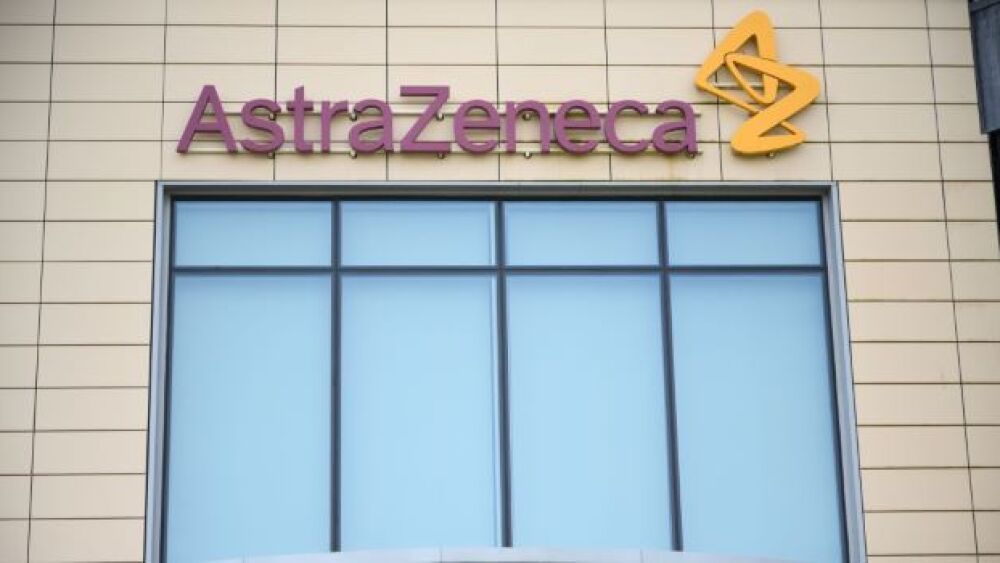AstraZeneca presented data showing Imfinzi and Tagrisso boosted survival chances for patients in different forms of lung cancer at ESMO on Monday.
Leon Neal/Getty Images
AstraZeneca presented data showing Imfinzi and Tagrisso boosted survival chances for patients with different forms of lung cancer at the European Society of Medical Oncology (ESMO) Congress Monday.
Exploratory analysis from the Phase III POSEIDON trial showed checkpoint inhibitor Imfinzi combined with tremelimumab and multiple rounds of chemotherapy demonstrated a sustained improvement in overall survival compared to chemotherapy alone in the first-line treatment of Stage IV (metastatic) non-small cell lung cancer.
The Imfinzi/tremelimumab duo plus chemotherapy improved overall survival (OS) by 25% compared to chemotherapy alone. Median OS was 14 months compared to 11.7 months for chemotherapy alone.
AstraZeneca reported that an estimated 25% of trial patients treated with the combination were alive after three years. This compared to 13.6% for those treated with chemotherapy alone, the company reported.
Camille Hertzka, vice president and head of oncology for AstraZeneca, U.S. medical, told BioSpace it wasn’t too long ago that metastatic lung cancer patients were told they only had about one year to live following diagnosis.
“This is extremely meaningful data,” she said. “Now, seeing 25% of patients alive at three years means that we have patients having three other Christmases, three other birthdays, three other meaningful events.”
The exploratory analyses continue to show trends for survival improvement in patients with different disease mutations, including those with STK11, KEAP1 and KRAS-mutated NSCLC, and patients whose tumors were PD-L1-negative, AstraZeneca reported. These mutations are associated with poor outcomes.
The risk of death was reduced by 38% for cancer patients with the STK11 mutation, AstraZeneca shared. For those with KEAP1, and KRAS-mutated forms of metastatic NSCLC, the risk of death was reduced by 57% and 45%, respectively.
AstraZeneca noted that sustained OS benefits were also seen in patients with less than 1% PD-L1 tumor cell expression. However, these analyses of patient subgroups “should be interpreted with caution” due to the size of the samples, the company advised.
Although caution was recommended, Hertzka said she couldn’t help but be excited about what researchers have seen with these patients. Despite the advances in lung cancer, she said there remains an unmet need for patients with these mutations.
“We are talking about hard-to-treat patients,” Hertzka said, adding, “This is the first time we’re seeing something that’s exciting” for this patient population.
Based on data from POSEIDON, the combination of Imfinizi and Tremelimumab plus chemotherapy is under review by global regulatory agencies.
Tagrisso Makes Meaningful Impact at Four-Year Mark
In a separate abstract, AstraZeneca’s Tagrisso showed a sustained, clinically meaningful improvement in disease-free survival in the adjuvant treatment of patients with early-stage epidermal growth factor receptor-mutated (EGFRm) non-small cell lung cancer following complete tumor resection.
Data from the Phase III ADAURA study showed nearly three in four patients treated with adjuvant Tagrisso were alive and disease-free at four years, the company announced.
The data, from a two-year follow-up from the 2020 trial readout, showed Tagrisso reduced risk of disease recurrence or death by 77% in the primary analysis population. This consisted of patients with Stages II and IIIa disease. In the overall population, which included Stages Ib-IIIa, the reduction was 73%.
AstraZeneca noted that a median disease-free survival of 65.8 months, about five and a half years, was seen in both the primary and overall populations treated with Tagrisso. This compared to 21.9 and 28.1 months in the primary and overall populations, respectively, treated with placebo.
Katy Platt Miller, VP and U.S. franchise head of lung cancer at AstraZeneca, told BioSpace the addition of Tagrisso to these early-stage patients demonstrated sustained and clinically meaningful improvement in disease-free survival. For patients who are diagnosed early enough, Platt Miller said the addition of Tagrisso provides them with years of living their lives without the threat of recurring cancer.
“For us, that time of prolonging...life is really, really meaningful,” she said from Paris this morning.
Dr. Roy Herbst, a Yale University lung cancer researcher and trial investigator, echoed Platt Miller. He called the median disease-free survival of 65.8 months “phenomenal”, saying it shows treatment with Tagrisso for this lung cancer population is “the best insurance policy against disease recurrence.”
In addition to the disease-free survival data, treatment with Tagrisso also reduced the risk of disease recurrence in the brain or spinal cord by 76% in patients with Stage II-IIIA disease. Herbst said this is significant data.
“Brain metastases is the biggest concern for patients. When it recurs, the disease goes to the brain 20 to 30% of the time,” he said. “(Tagrisso) has a systemic effect. The progress we’re making is extraordinary.”





